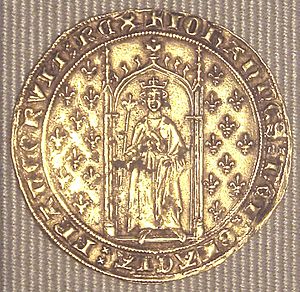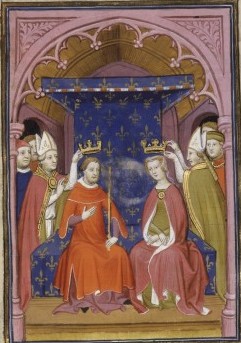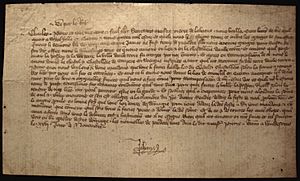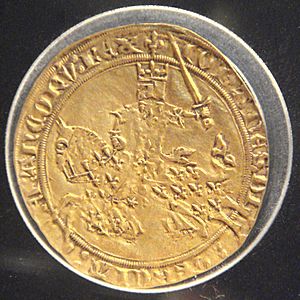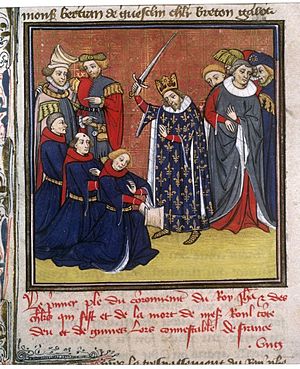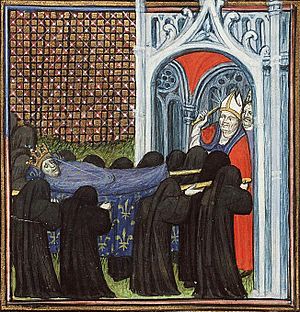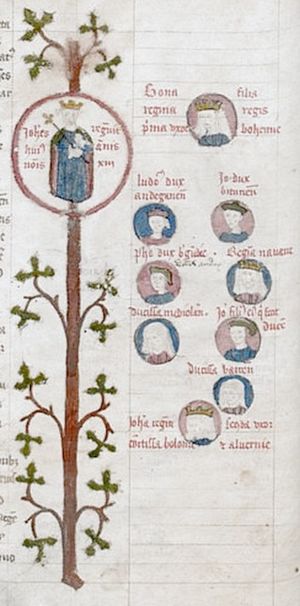John II of France facts for kids
Quick facts for kids John II |
|
|---|---|
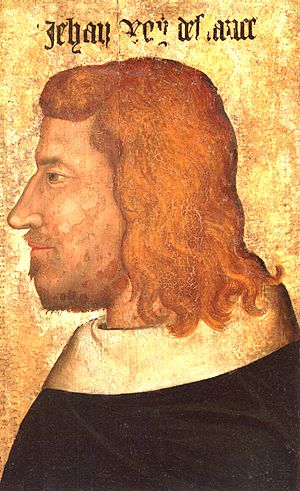
Portrait on wood panel around 1350, Louvre Museum
|
|
| King of France (more...) | |
| Reign | 22 August 1350 – 8 April 1364 |
| Coronation | 26 September 1350 |
| Predecessor | Philip VI |
| Successor | Charles V |
| Regent | Dauphin Charles (1356–1360) |
| Born | 26 April 1319 Le Mans, France |
| Died | 8 April 1364 (aged 44) Savoy Palace, London, England |
| Burial | 7 May 1364 Saint Denis Basilica |
| Spouse |
|
| Issue | Charles V of France Louis I, Duke of Anjou John, Duke of Berry Philip II, Duke of Burgundy Joan, Queen of Navarre Marie, Duchess of Bar Isabella, Countess of Vertus |
| House | Valois |
| Father | Philip VI of France |
| Mother | Joan of Burgundy |
John II (born 26 April 1319 – died 8 April 1364), also known as John the Good, was the King of France from 1350 until his death in 1364. When he became king, France was facing many big problems. These included the Black Death, which killed almost half of the population. There were also peasant revolts and groups of soldiers called free companies who robbed the country. England was also attacking France, leading to huge military losses. One major defeat was the Battle of Poitiers in 1356, where King John was captured.
While John was held prisoner in London, his son Charles became the regent, meaning he ruled in his father's place. Charles had to deal with several rebellions, but he managed to overcome them. To free his father, Charles signed the Treaty of Brétigny in 1360. This treaty meant France lost many lands and had to pay a huge amount of money as ransom. John was released in exchange for other important people, including his second son Louis, Duke of Anjou, who became a hostage. John returned to France to gather the money for his ransom. He created the franc coin to help make the country's money stable again. He also tried to get rid of the free companies by sending them on a crusade. However, Pope Innocent VI died before their meeting. When John found out that Louis had escaped from being a hostage, he bravely decided to return to England himself. He died there in 1364. His son Charles V became the next king.
Contents
Early Life of John II
John was nine years old when his father, Philip VI, became king of France. Philip VI's rise to the throne was unexpected. Several of Philip IV's sons had died without sons of their own. Because of a rule called Salic law, women could not inherit the throne. This meant that all female relatives were passed over. There was also a disagreement because Edward III of England, Philip IV's grandson through his daughter Isabella, had a claim to the throne.
As the new King of France, John's father Philip VI needed to make his power strong. He wanted to protect his throne from others who claimed it. So, he decided to marry his son John quickly when he was thirteen. This marriage would create a strong alliance. At the same time, John was given the important title of Duke of Normandy.
Finding a Wife and First Marriage
At first, people thought John might marry Eleanor of Woodstock, who was the sister of King Edward III of England. But instead, Philip invited John of Luxembourg, the King of Bohemia, to Fontainebleau. Bohemia wanted to control Lombardy and needed France's help. They made a treaty. It said that Bohemia would send 400 soldiers to help the French army if there was a war. It also said that Bohemia's claim to the Lombard crown would not be questioned.
Philip chose Bonne of Bohemia to be John's wife. She was 16 years old and ready to have children. Her family agreed to pay a dowry of 120,000 florins.
John turned 13 on April 27, 1332. This meant he was old enough to rule. He became the leader of the duchy of Normandy, and also the counties of Anjou and Maine. The wedding happened on July 28 at the church of Notre-Dame in Melun. Six thousand guests were there! The celebrations lasted for two more months. Then, John was made a knight at the Notre-Dame Cathedral in Paris. As the new Duke of Normandy, John was given the special arms of a knight. Many important people watched, including the kings of Bohemia and Navarre.
John as Duke of Normandy
Challenges and English Influence
When John became Duke of Normandy in 1332, he faced a challenge. Most of the nobles in Normandy were already friends with England. Normandy relied more on trade across the English Channel than on trade along the Seine river. Many landowners in Normandy also owned land in England. This meant they risked losing their land if they chose sides. So, the Norman nobles often worked together in groups. This helped them keep special rights and some independence for their duchy. Normandy was split into two main groups: the counts of Tancarville and the counts of Harcourt. These groups had been fighting for many years.
In 1341, problems started again. King Philip was worried about the richest part of his kingdom falling into chaos. He told his officers to stop the fighting. But Geoffroy d'Harcourt gathered soldiers against the king. Many nobles who wanted to keep their independence joined him. The rebels wanted Geoffroy to become duke, which would guarantee their freedom. Royal troops took over the castle at Saint-Sauveur-le-Vicomte. Geoffroy was sent away to Brabant. Three of his friends were executed in Paris on April 3, 1344.
Meetings with Important Leaders
In 1342, John visited Avignon, which was then part of the Papal States. He was there for the crowning of Pope Clement VI. Later in 1343, he was part of a meeting to discuss peace with a clerk from Edward III of England's office. Clement VI was one of seven popes who lived in Avignon.
Troubles in Normandy and Growing Tensions
By 1345, more and more Norman rebels started to support Edward III. This was a big threat to the French kings. The defeat at the Battle of Crécy on August 26, 1346, and the surrender of Calais on August 3, 1347, after a long siege, hurt the king's reputation even more. Many nobles, especially in the north and west, started to switch their loyalty to England because of its strong economy.
King Philip VI decided to try for a truce. Duke John met with Geoffroy d'Harcourt. The king agreed to give Geoffroy back all his seized property. He even made him a special captain in Normandy. John then tried to get the Tancarville family to be loyal to him. The marriage of John, Viscount of Melun, to Jeanne, who was the only heir of the Tancarville county, helped keep the Melun-Tancarville group loyal to John. Meanwhile, Geoffroy d'Harcourt continued to fight for Norman freedoms.
The Black Death and Second Marriage
On September 11, 1349, John's wife, Bonne of Bohemia, died at the Maubuisson Abbey near Paris. She died from the Black Death, a terrible sickness that was spreading across Europe. To escape the disease, John, who was living in the royal palace in Paris, left the city.
On February 9, 1350, five months after his first wife died, John married Joan I, Countess of Auvergne. They were married at the royal Château de Sainte-Gemme, near Saint-Germain-en-Laye.
John Becomes King of France
Coronation Ceremony
Philip VI, John's father, died on August 22, 1350. John was crowned as John II, King of France, in Reims on September 26. Joanna, his second wife, was crowned Queen of France at the same time.
In November 1350, King John had Raoul II of Brienne, Count of Eu arrested and quickly executed. The reasons are not fully clear, but it was rumored that he had promised the English the County of Guînes in exchange for his freedom.
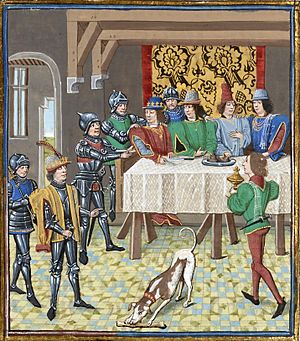
In 1354, John's son-in-law and cousin, Charles II of Navarre, was involved in killing Charles de la Cerda. Charles of Navarre was a king in the Pyrenees mountains and also owned a lot of land in Normandy. Charles de la Cerda was a close friend of King John. Even so, John signed a treaty with Charles of Navarre in 1354 to have him as an ally against the English.
However, the peace did not last. Charles of Navarre later made an alliance with Henry of Grosmont, an English duke. In 1355, John and Charles signed another treaty, but this peace also did not last long. On April 5, 1356, a dramatic event happened during a banquet at the Royal Castle in Rouen. King John, along with his brother and cousins, burst into the room in full armor. John grabbed Charles of Navarre, shouting that no one should move. John's son, Dauphin Charles, who was hosting the banquet, begged his father to stop. The King pulled Navarre from his chair, calling him a "Traitor." He then ordered the arrest of all the guests, including Navarre. That night, John had John, the Count of Harcourt, and several other Norman lords executed nearby.
Many people thought this was a rash decision and a political mistake. This act, driven by revenge for the death of John's friend Charles de La Cerda, pushed many Norman lords to support King Edward and England. This set the stage for the English invasion and the Battle of Poitiers.
The Battle of Poitiers
In 1355, the Hundred Years' War started up again. In July 1356, Edward, the Black Prince, who was the son of Edward III of England, led his army on a long raid through France. King John chased him with his own army. In September, the two armies met a few miles southeast of Poitiers.
John was sure he would win because his army was probably twice as big as the English army. But he did not attack right away. While he waited, a church leader tried to arrange a truce between the two sides. It is debated whether the Black Prince even wanted to fight. He offered his wagons, which were full of stolen goods. He also promised not to fight against France for seven years. Some say he even offered to give Calais back to the French. John demanded that 100 of the Prince's best knights, along with the Prince himself, surrender as hostages. No agreement could be reached. The talks failed, and both sides got ready to fight.
On the day of the battle, John and 17 knights from his personal guard dressed exactly alike. This was to confuse the enemy, who would try hard to capture the king. Despite this plan, the large French knight force was defeated by the English longbow archers. John was captured when the English charged to finish their victory. He fought bravely with a large battle-axe, but his helmet was knocked off. Surrounded, he kept fighting until Denis de Morbecque, a French exile fighting for England, came up to him.
"Sir," Morbecque said. "I am a knight from Artois. Give yourself up to me, and I will take you to the Prince of Wales."
Surrender and Capture
King John surrendered by giving his glove to the knight. That night, King John ate dinner in the red silk tent of his enemy. The Black Prince personally looked after him. John was then taken to Bordeaux, and from there to England. The Battle of Poitiers was one of the biggest military disasters for France during the Middle Ages.
While peace talks were happening, John was first held at the Savoy Palace. Then he was moved to different places, including Windsor, Hertford, and the Tower of London.
Being a Prisoner in England
As a prisoner of the English, John was given special royal treatment. He was allowed to travel and live like a king. At this time, France was having problems with law and order, and the government struggled to raise money for defense. But John's records from his time as a prisoner show he bought horses, pets, and clothes. He also had an astrologer and a court band.
The Treaty of Brétigny
The Treaty of Brétigny (written in May 1360) set his ransom at a huge 3 million crowns. This was about two or three years' worth of money for the French Crown, which had the largest national budget in Europe then. On June 30, 1360, John left the Tower of London. He went to Eltham Palace, where Queen Philippa had prepared a big farewell party. He stayed the night at Dartford and continued towards Dover. He stopped at the Maison Dieu of St Mary at Ospringe and paid respects at the shrine of St Thomas Becket at Canterbury on July 4. He ate dinner with the Black Prince, who had helped negotiate the treaty, at Dover Castle. He reached English-held Calais on July 8.
John left his son Louis of Anjou in Calais as a replacement hostage to make sure the payment would be made. John was then allowed to return to France to raise the money. The Treaty of Brétigny was officially approved in October 1360.
Louis' Escape and John's Return to England
On July 1, 1363, King John learned that Louis had broken his promise and escaped from Calais. John was upset by this dishonorable act and by the unpaid ransom. He gathered his royal council to announce that he would willingly return to England and talk with Edward himself. When his advisors disagreed, the king famously said that "if good faith were banned from the Earth, she ought to find asylum in the hearts of kings." Right after this, he made his son Charles the Duke of Normandy. Charles would be regent and governor of France until John returned.
Death of King John
John arrived in England in January 1364. He was met by important knights and lords at Dover. He was taken to Eltham and the Savoy Palace. He was warmly welcomed in London in January 1364. He was treated with great honor and often visited Edward at Westminster. However, a few months after he arrived, he became sick with an unknown illness. He died at the Savoy Palace in April 1364. His body was returned to France and buried in the royal tombs at Saint Denis Basilica.
Personality of John II
Physical Strength and Hobbies
John was not very strong physically. He did not do much physical activity and rarely took part in jousting. He preferred hunting instead. People at the time said he got angry quickly and could be violent. This often led to problems in politics and with other countries. He enjoyed reading and supported artists and musicians.
Public Image
The idea of John as a "warrior king" likely came from his bravery at the Battle of Poitiers. There, he got off his horse to fight at the front with his surrounded men, using a poleaxe. He also created the Order of the Star, a group of knights. This image was important for political reasons. John wanted to prove that he was the rightful king. His reign, like his father's, had ongoing arguments about who should be king, from both Charles II of Navarre and Edward III of England. From a young age, John had to deal with groups in cities and among nobles who wanted more power. These groups were often influenced by England or wanted changes. He grew up around secrets and betrayals. Because of this, he ruled secretly, only trusting a small group of close advisors.
Personal Relationships
John married Bonne of Bohemia and had 11 children in eleven years. He had a very close friend named Charles de la Cerda. People who supported Charles II of Navarre made fun of the king for "having no other God than him." La Cerda was given many honors and became a very important official called connetable when John became king. He went with the king on all his official trips. La Cerda's rise to power made other French nobles jealous. Several of them killed him in 1354. John was very sad and showed his grief publicly after La Cerda's death.
John II's Children
On July 28, 1332, when he was 13, John married Bonne of Luxembourg (died 1349). She was the daughter of John, King of Bohemia. Their children were:
- Charles V of France (born 1338 – died 1380)
- Catherine (born and died 1338)
- Louis I, Duke of Anjou (born 1339 – died 1384), married Marie of Blois
- John, Duke of Berry (born 1340 – died 1416), married Jeanne of Auvergne
- Philip II, Duke of Burgundy (born 1342 – died 1404), married Margaret of Flanders
- Joan (born 1343 – died 1373), married Charles II (the Bad) of Navarre
- Marie (born 1344 – died 1404), married Robert I, Duke of Bar
- Agnes (born 1345 – died 1350)
- Margaret (born 1347 – died 1352)
- Isabelle (born 1348 – died 1372), married Gian Galeazzo I, Duke of Milan
On February 19, 1350, John married Joanna I of Auvergne (died 1361) at the royal Château de Sainte-Gemme. Joanna was the widow of Philip of Burgundy. She was also the mother of young Philip I, Duke of Burgundy (1344–61), who became John's stepson. John and Joanna had three children, but all of them died soon after birth:
- Blanche (born November 1350)
- Catherine (born early 1352)
- A son (born early 1353)
Succession to the Throne
John II was followed as king by his son, Charles. Charles ruled as Charles V of France, and he was known as The Wise.
|
See also
 In Spanish: Juan II de Francia para niños
In Spanish: Juan II de Francia para niños



